wandEditor 富文本源码分析
概述
使用 editorjs 开发富文本编辑器,发现行内工具如加粗、斜体、删除线、颜色背景等操作要自己实现,现成的 document.execCommand API 有各种限制和体验问题,官方也说了有可能会废除(历史原因不能这么干)
调研了市面上的产品,slate.js 框架能实现工具栏的功能,做到与框架无关,不过要进行大量的二次开发,封装复杂,而 wangEditor 正好是基于 slate.js 实现,于是分析 wangEditor 源码实现,方便将 slate.js 集成到 editor.js ,记录了 wangEditor 渲染流程。
架构分析
wangEditor 使用 lerna 进行代码管理,底层依赖 slate.js 和 snabbdom 库实现
- slate.js 库负责对文本、节点内容处理,如文本操作(字体加粗、下划线、删除线、颜色、背景等)、元素操作(插入段落、标题、列表、表格、图片等)
- wangEditor 没有使用
slate-react渲染 ,它与框架无关,可以使用在 Vue、React 项目,渲染使用 snabbdom,利用 patch diff 提升更新的性能
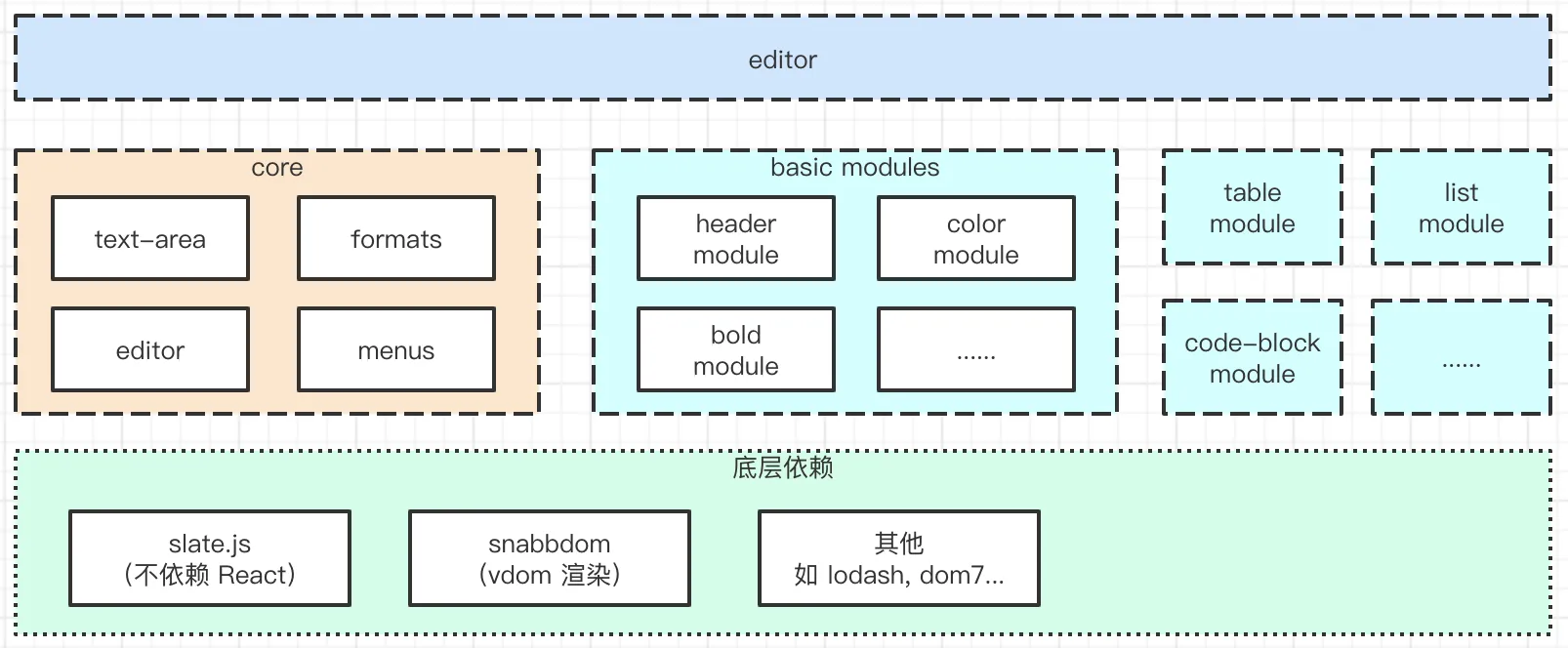
wangEditor 代码拆分到 packages 子模块下,方便扩展和维护
core是核心模块,包含了 TextArea 类,编辑器 editor 操作方法 、文本格式 formats、菜单操作 menus,是编辑器的核心逻辑editor模块是打包的入口模块,项目引入使用@wangeditor/editor包也是这个模块,它在入口文件,将 basic-modules(段落、标题模块等集合)、代码高亮、列表、表格、 图片、视频这些分散的模块进行批量注册,使用 Boot 静态类进行统一管理,在编辑器实例化,将Boot.plugins插件传入core包注册使用
总的来说,editor 模块相当于出口,作为中间桥梁,将核心包 core 和其他功能模块的包很好的集成在一起,既方便代码管理,也能通过插件机制,很好的扩展其他功能模块。
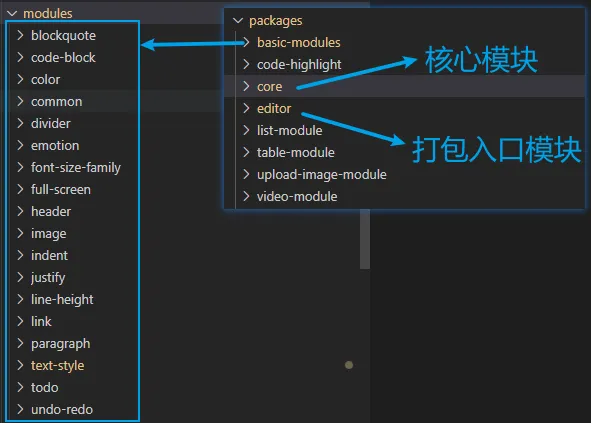
开始使用
wangEditor 富文本将 编辑内容区域 和 工具栏 分成两步使用
- 第一步:
createEditor方法创建 editor 编辑器实例对象, 同时渲染编辑器内容数据 - 第二步:
createToolbar方法传入 editor 对象,实例化编辑器工具栏,调用 editor 对象的方法可以对文本进行加粗、斜体、删除线等操作
这样设计的好处,可以实现工具栏定制化,可有可无,满足更多的业务场景。同时通过 editor 对象保持工具栏和编辑器的数据同步和一致性
import { createEditor, createToolbar } from '@wangeditor/editor'
// editor 配置
const editorConfig = {}
const editor = createEditor({
selector: '#editor-text-area',
config: editorConfig,
html: '<p>hello</p>',
mode: 'simple'
})
const toolbar = createToolbar({
editor,
selector: '#editor-toolbar',
config: {},
mode: 'simple'
})
编辑器的页面渲染,是以数据驱动,数据存储到 editor.children
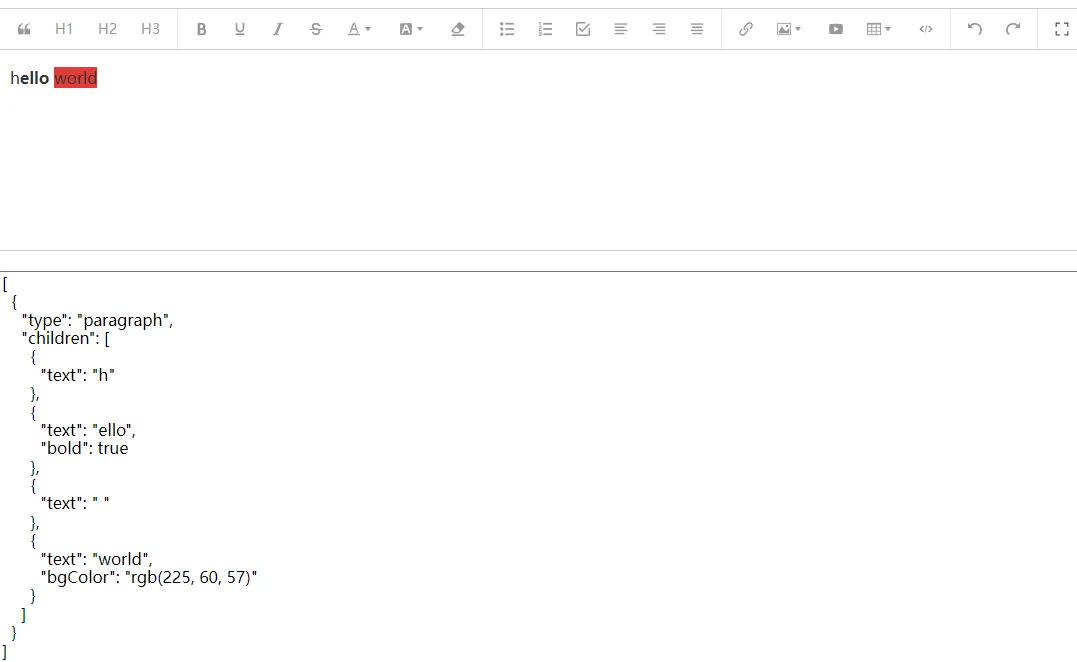
富文本渲染流程
注册内置模块
在入口文件,自动注册内置模块,将 basic-modules、list-module 等分散的模块进行批量注册
// packages/editor/src/index.ts
import './register-builtin-modules/index'
引入文件后,自动执行
// register-builtin-modules/index
import basicModules from '@wangeditor/basic-modules'
import wangEditorListModule from '@wangeditor/list-module'
import wangEditorTableModule from '@wangeditor/table-module'
import wangEditorVideoModule from '@wangeditor/video-module'
import wangEditorUploadImageModule from '@wangeditor/upload-image-module'
import { wangEditorCodeHighlightModule } from '@wangeditor/code-highlight'
import registerModule from './register'
basicModules.forEach((module) => registerModule(module))
registerModule(wangEditorListModule)
registerModule(wangEditorTableModule)
registerModule(wangEditorVideoModule)
registerModule(wangEditorUploadImageModule)
registerModule(wangEditorCodeHighlightModule)
调用 registerModule 注册函数,将模块数据添加到静态类 Boot
富文本实例化
执行函数 coreCreateEditor,内部调用 slate.js 框架的 createEditor 实例化编辑器,并返回 editor 对象
/**
* 创建 editor 实例
*/
export function createEditor() {
const editor = coreCreateEditor({
selector,
config: {
...globalConfig, // 全局配置
...config,
hoverbarKeys: newHoverbarKeys,
},
content,
html,
plugins: Boot.plugins,
})
return editor
}
coreCreateEditor 执行操作
- 调用 slate.js 库
createEditor()函数实例化编辑器,并基于它提供的插件机制,做了很多扩展,类似洋葱模型 - 将传入
html转换为 json,存入editor.children数据渲染,content字段优先级比html高 - 实例化
TextArea,调用textarea.changeViewState渲染视图
// packages/core/src/create/create-editor.ts
export default function coreCreateEditor (option) {
const { selector = '', config = {}, content, html, plugins = [] } = option
// 创建实例 - 使用插件
let editor = withHistory(
withMaxLength(
withEmitter(withSelection(withContent(withConfig(withDOM(withEventData(createEditor()))))))
)
)
if (selector) {
// 处理配置
const editorConfig = genEditorConfig(config)
// 注册第三方插件
plugins.forEach(plugin => {
editor = plugin(editor)
})
// 初始化内容(要在 config 和 plugins 后面)
if (html != null) {
// 传入 html ,转换为 JSON content
editor.children = htmlToContent(editor, html)
}
if (content && content.length) {
editor.children = content // 传入 JSON content
}
if (editor.children.length === 0) {
editor.children = genDefaultContent() // 默认内容
}
DomEditor.normalizeContent(editor) // 格式化,用户输入的 content 可能不规范(如两个相连的 text 没有合并)
if (selector) {
// 传入了 selector ,则创建 textarea DOM
const textarea = new TextArea(selector)
// 视图更新
textarea.changeViewState() // 初始化时触发一次,以便能初始化 textarea DOM 和 selection
return editor
}
批量注册的插件,遍历 plugins 数组函数,传入 editor 挂载或重写 编辑器实例对象方法
渲染视图
changeViewState 调用 updateView 方法,使用 editor.children 数据渲染富文本内容
注:editorSelectionToDOM 方法是在工具栏操作如加粗,它是数据驱动,修改了 editor.children 数据结构,派发 change 事件 changeViewState 重新渲染了,要处理 editor.section 新的选中范围 range
// packages/core/src/text-area/TextArea.ts
changeViewState() {
const editor = this.editorInstance
// 更新 DOM
// TODO 注意这里是否会有性能瓶颈?因为每次键盘输入,都会触发这里 —— 可单独测试大文件、多内容,如几万个字
updateView(this, editor)
// 处理 placeholder
handlePlaceholder(this, editor)
// 同步选区(异步,否则拿不到 DOM 渲染结果,vdom)
promiseResolveThen(() => {
editorSelectionToDOM(this, editor)
})
}
updateView 方法更新视图
- 节点转化 vdom:通过遍历
editor.children,调用node2Vnode将数据转换为 vdom 虚拟 DOM,children 深层递归处理 - 首次渲染,创建编辑区域 dom 添加到页面,使用 patchFn 函数将 vdom 更新上去,存储 patch 函数减少初始化
- 当重新渲染,取出缓存的 patch 和 旧的 vdom,使用 diff 进行更新
// 文件路径 packages/core/src/text-area/update-view.ts
/**
* 获取 editor.children 渲染 DOM
* @param textarea textarea
* @param editor editor
*/
function updateView(textarea: TextArea, editor: IDomEditor) {
const $scroll = textarea.$scroll
const elemId = genElemId(textarea.id)
// 生成 newVnode
const newVnode = genRootVnode(elemId, readOnly)
const content = editor.children || []
newVnode.children = content.map((node, i) => {
let vnode = node2Vnode(node, i, editor, editor)
normalizeVnodeData(vnode) // 整理 vnode.data 以符合 snabbdom 的要求
return vnode
})
let textareaElem
let isFirstPatch = IS_FIRST_PATCH.get(textarea)
if (isFirstPatch == null) isFirstPatch = true // 尚未赋值,也是第一次
if (isFirstPatch) {
// 第一次 patch ,先生成 elem
const $textArea = genRootElem(elemId, readOnly)
$scroll.append($textArea)
textarea.$textArea = $textArea // 存储下编辑区域的 DOM 节点
textareaElem = $textArea[0]
// 再生成 patch 函数,并执行
const patchFn = genPatchFn()
patchFn(textareaElem, newVnode)
// 存储相关信息
IS_FIRST_PATCH.set(textarea, false) // 不再是第一次 patch
TEXTAREA_TO_PATCH_FN.set(textarea, patchFn) // 存储 patch 函数
} else {
// 不是第一次 patch
const curVnode = TEXTAREA_TO_VNODE.get(textarea)
const patchFn = TEXTAREA_TO_PATCH_FN.get(textarea)
if (curVnode == null || patchFn == null) return
textareaElem = curVnode.elm
patchFn(curVnode, newVnode)
}
//...
}
node2Vnode 方法将对象转换为 vnode,区分元素和文本,renderElement 负责元素渲染,renderText 负责文本渲染
// packages/core/src/render/node2Vnode.ts
/**
* 根据 slate node 生成 snabbdom vnode
*/
export function node2Vnode(node, index, parent, editor) {
let vnode: VNode
if (Element.isElement(node)) {
// element
vnode = renderElement(node, editor)
} else {
// text
vnode = renderText(node, parent, editor)
}
return vnode
}
元素渲染 renderElement
以段落为例,段落数据结构如下
const paragraph = {
type: 'paragraph',
children: [{ text: '段落中的一行文本。' }]
}
getRenderElem 根据 type 类型获取对应段落渲染函数,段落的 children 使用 node2Vnode 递归处理,样式使用 renderStyle 处理
function renderElement(elemNode, editor): VNode {
//...
// 根据 type 生成 vnode 的函数
const { type, children = [] } = elemNode
let renderElem = getRenderElem(type)
childrenVnode = children.map((child: Node, index: number) => {
return node2Vnode(child, index, elemNode, editor)
})
// 创建 vnode
let vnode = renderElem(elemNode, childrenVnode, editor)
// 添加文本相关的样式,如 text-align
if (!isVoid && !isInline) {
// 非 void + 非 inline
vnode = renderStyle(elemNode, vnode)
}
return vnode
}
在模块注册的时候,使用 registerRenderElemConf 添加到 RENDER_ELEM_CONF 对象上,getRenderElem 根据 type 获取
function getRenderElem(type: string): RenderElemFnType {
const fn = RENDER_ELEM_CONF[type]
return fn || defaultRender
}
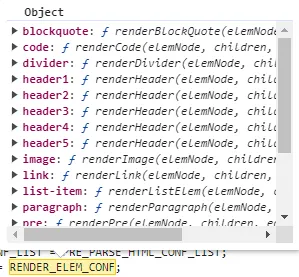
段落渲染函数
// packages/basic-modules/src/modules/paragraph/render-elem.tsx
function renderParagraph(
elemNode: SlateElement,
children: VNode[] | null,
editor: IDomEditor
): VNode {
const vnode = <p>{children}</p>
return vnode
}
export const renderParagraphConf = {
type: 'paragraph',
renderElem: renderParagraph
}
文本渲染 renderText
renderText 处理文本节点,主要是样式的处理,例如加粗、下划线、删除线,addTextVnodeStyle 实现
function renderText(textNode: SlateText, parent: Ancestor, editor: IDomEditor): VNode {
//...
// 根据 decorate 将 text 拆分为多个叶子节点 text[]
const { decorate } = editor.getConfig()
if (decorate == null) throw new Error(`Can not get config.decorate`)
const path = DomEditor.findPath(editor, textNode)
const ds = decorate([textNode, path])
const leaves = SlateText.decorations(textNode, ds)
// 生成 leaves vnode
const leavesVnode = leaves.map((leafNode, index) => {
// 文字和样式
const isLast = index === leaves.length - 1
let strVnode = genTextVnode(leafNode, isLast, textNode, parent, editor)
strVnode = addTextVnodeStyle(leafNode, strVnode)
// 生成每一个 leaf 节点
return <span data-slate-leaf>{strVnode}</span>
})
// 生成 text vnode
const textId = genTextId(key.id)
const vnode = (
<span data-slate-node="text" id={textId} key={key.id}>
{leavesVnode /* 一个 text 可能包含多个 leaf */}
</span>
)
return vnode
}
addTextVnodeStyle 会从注册的 RENDER_STYLE_HANDLER_LIST 样式数组中遍历,如果节点中有设置了样式属性,则添加该样式
/**
* 给字符串增加样式
* @param leafNode slate text leaf node
* @param textVnode textVnode
*/
function addTextVnodeStyle(leafNode: SlateText, textVnode: VNode): VNode {
let newTextVnode = textVnode
RENDER_STYLE_HANDLER_LIST.forEach(styleHandler => {
newTextVnode = styleHandler(leafNode, newTextVnode)
})
return newTextVnode
}
插件注册样式 registerStyleHandler 函数,在 Boot.registerRenderStyle 方法调用
/**
* 注册处理文本样式的函数
* @param fn 处理文本样式的函数
*/
export function registerStyleHandler(fn: RenderStyleFnType) {
RENDER_STYLE_HANDLER_LIST.push(fn)
}
以文本处理 text-style 为例,根据节点是否有设置样式属性,使用标签包裹文本
// packages/basic-modules/src/modules/text-style/render-style.tsx
/**
* 添加样式
* @param node slate text
* @param vnode vnode
* @returns vnode
*/
export function renderStyle(node: Descendant, vnode: VNode): VNode {
const { bold, italic, underline, code, through, sub, sup } = node as StyledText
let styleVnode: VNode = vnode
// color bgColor 在另外的菜单
if (bold) {
styleVnode = <strong>{styleVnode}</strong>
}
if (code) {
styleVnode = <code>{styleVnode}</code>
}
if (italic) {
styleVnode = <em>{styleVnode}</em>
}
if (underline) {
styleVnode = <u>{styleVnode}</u>
}
if (through) {
styleVnode = <s>{styleVnode}</s>
}
if (sub) {
styleVnode = <sub>{styleVnode}</sub>
}
if (sup) {
styleVnode = <sup>{styleVnode}</sup>
}
return styleVnode
}
渲染的流程图
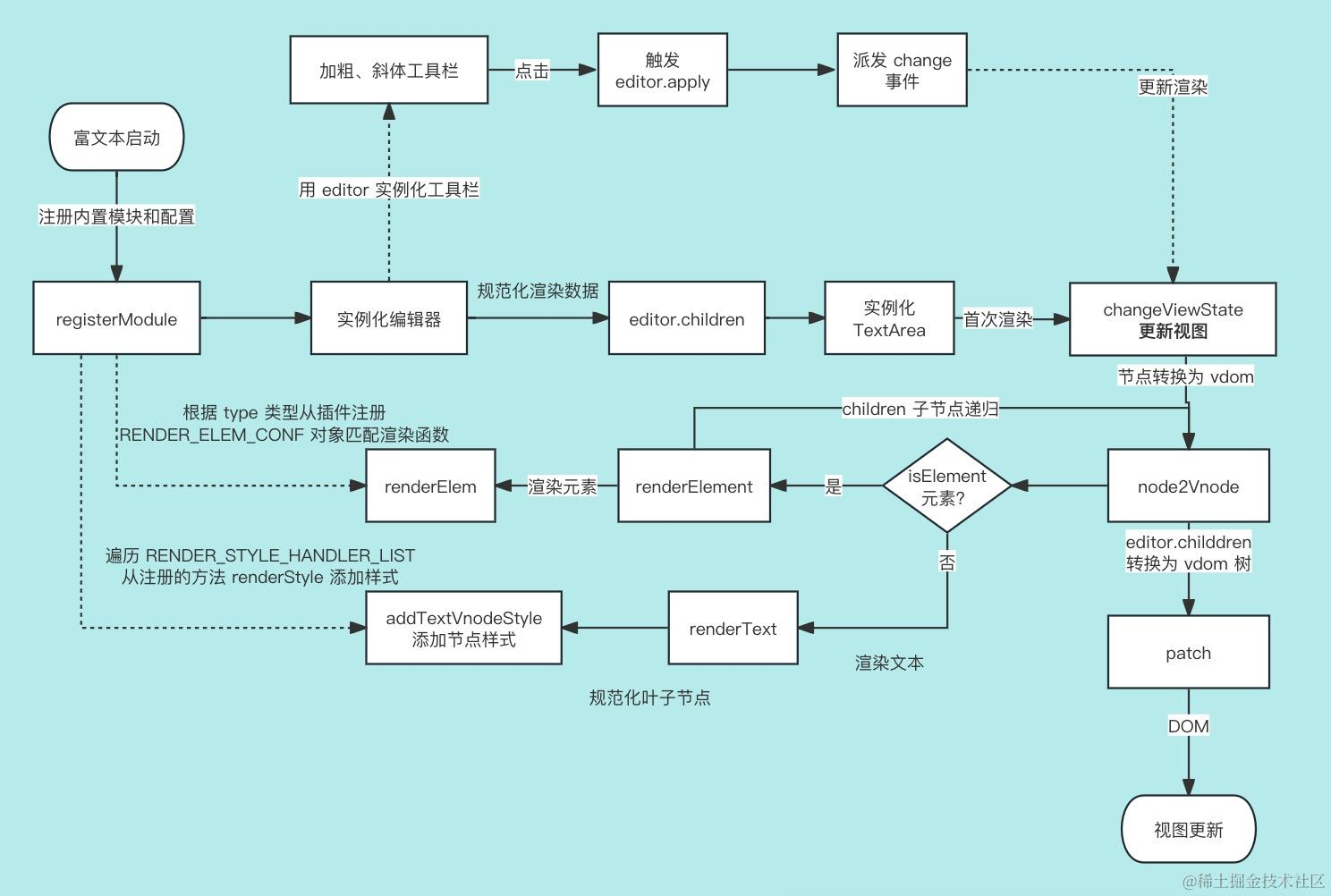
 jeffery-blog
jeffery-blog